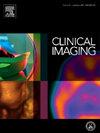CAR T-cell therapy chest CT manifestations
IF 1.8
4区 医学
Q3 RADIOLOGY, NUCLEAR MEDICINE & MEDICAL IMAGING
引用次数: 0
Abstract
Purpose
CAR T-cell therapy is an emerging anti-cancer therapeutic using modified T cells to attack a patient's cancer. The purpose of this study was to assess chest CT findings in patients undergoing CAR T-cell therapy to determine the most common CT manifestations.
Methods
We performed a retrospective test-retest study analyzing cases of patients who received CAR T-cell therapy who underwent chest CT prior to therapy and after therapy; a total of 349 patients were identified. CAR T-cell therapy was first administered in the mid 2010's, however we assessed for pre-treatment scans prior to this date. We reviewed patient's charts to collect demographic and clinical data. Two cardiothoracic radiologists reviewed chest CT scans prior to and post CAR T-cell therapy to determine new radiologic features post therapy. We analyzed which findings correlated with specific radiologic features on chest CT using student's t-tests or Chi squared tests.
Results
Pleural effusion was the most common CT manifestation resulting from CAR T-cell therapy, found in 26.3 % of patients. Patients with CT manifestations were more likely to present with dyspnea and cough (p = 0.000031 and p = 0.02, respectively).
Discussion
New symptoms in patients treated with CAR T-cell therapy may be an important harbinger of radiologic abnormalities. Clinicians should have a high index of suspicion for pleural effusions in patients presenting with symptoms who have undergone CAR T-cell therapy.
求助全文
约1分钟内获得全文
求助全文
来源期刊

Clinical Imaging
医学-核医学
CiteScore
4.60
自引率
0.00%
发文量
265
审稿时长
35 days
期刊介绍:
The mission of Clinical Imaging is to publish, in a timely manner, the very best radiology research from the United States and around the world with special attention to the impact of medical imaging on patient care. The journal''s publications cover all imaging modalities, radiology issues related to patients, policy and practice improvements, and clinically-oriented imaging physics and informatics. The journal is a valuable resource for practicing radiologists, radiologists-in-training and other clinicians with an interest in imaging. Papers are carefully peer-reviewed and selected by our experienced subject editors who are leading experts spanning the range of imaging sub-specialties, which include:
-Body Imaging-
Breast Imaging-
Cardiothoracic Imaging-
Imaging Physics and Informatics-
Molecular Imaging and Nuclear Medicine-
Musculoskeletal and Emergency Imaging-
Neuroradiology-
Practice, Policy & Education-
Pediatric Imaging-
Vascular and Interventional Radiology
 求助内容:
求助内容: 应助结果提醒方式:
应助结果提醒方式:


